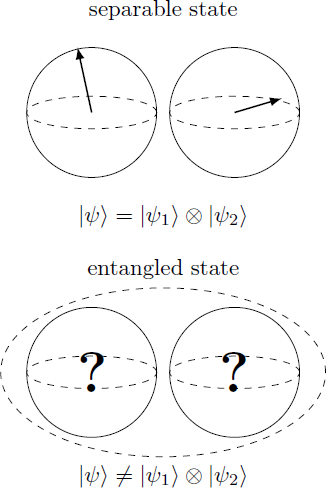Quantum Computing 3.1 -- Entangled or not?

Which of the possible answers is an entangled state of a qubit pair?
Details: A qubit pair state ∣ ψ ⟩ is separable if there is a representation as a tensor product ∣ ψ 1 ⟩ ⊗ ∣ ψ 2 ⟩ , so that ∣ ψ ⟩ = ∣ ψ 1 ⟩ ⊗ ∣ ψ 2 ⟩ = ( α 1 ∣ 0 ⟩ + β 1 ∣ 1 ⟩ ) ⊗ ( α 2 ∣ 0 ⟩ + β 2 ∣ 1 ⟩ ) = α 1 α 2 ∣ 0 0 ⟩ + α 1 β 2 ∣ 0 1 ⟩ + β 1 α 2 ∣ 1 0 ⟩ + β 1 β 2 ∣ 1 1 ⟩ α 1 , α 2 , β 1 , β 2 ∈ C ∣ ψ ⟩ is entangled , if such a representation is not possible. ( ∣ ψ ⟩ = ∣ ψ 1 ⟩ ⊗ ∣ ψ 2 ⟩ ) .
This section requires Javascript.
You are seeing this because something didn't load right. We suggest you, (a) try
refreshing the page, (b) enabling javascript if it is disabled on your browser and,
finally, (c)
loading the
non-javascript version of this page
. We're sorry about the hassle.
For three of the four possible answers, a decomposition in single states can be found: 2 1 ( ∣ 0 0 ⟩ − ∣ 1 0 ⟩ ) 2 1 ( ∣ 0 0 ⟩ + ∣ 0 1 ⟩ + ∣ 1 0 ⟩ + ∣ 1 1 ⟩ ) 2 1 ( ∣ 0 0 ⟩ + i ∣ 0 1 ⟩ + i ∣ 1 0 ⟩ − ∣ 1 1 ⟩ ) = 2 1 ( ∣ 0 ⟩ − ∣ 1 ⟩ ) ⊗ ∣ 0 ⟩ = 2 1 ( ∣ 0 ⟩ + ∣ 1 ⟩ ) ⊗ 2 1 ( ∣ 0 ⟩ + ∣ 1 ⟩ ) = 2 1 ( ∣ 0 ⟩ + i ∣ 1 ⟩ ) ⊗ 2 1 ( ∣ 0 ⟩ + i ∣ 1 ⟩ ) We are now trying to represent the fourth state as a tensor product ⇒ ⇒ ⇒ ⇒ 2 1 ( ∣ 0 1 ⟩ + ∣ 1 0 ⟩ ) α 1 α 2 = 0 α 1 or α 2 = 0 α 1 β 2 = 0 ∣ ψ ⟩ = ∣ 0 1 ⟩ = ! α 1 α 2 ∣ 0 0 ⟩ + α 1 β 2 ∣ 0 1 ⟩ + β 1 α 2 ∣ 1 0 ⟩ + β 1 β 2 ∣ 1 1 ⟩ and β 1 β 2 = 0 and β 1 or β 2 = 0 or β 1 α 2 = 0 or ∣ ψ ⟩ = ∣ 1 0 ⟩ Thus we receive a contradiction. Therefore, this state must be entangled. In particular, this state has the special name ∣ Ψ + ⟩ and belongs to the four Bell states ∣ Φ ± ⟩ ∣ Ψ ± ⟩ = 2 1 ( ∣ 0 0 ⟩ ± ∣ 1 1 ⟩ ) = 2 1 ( ∣ 0 1 ⟩ ± ∣ 1 0 ⟩ ) which are all maximally entangled.